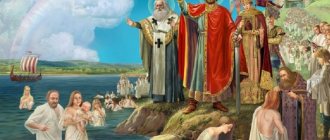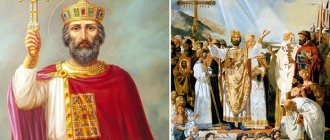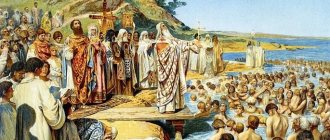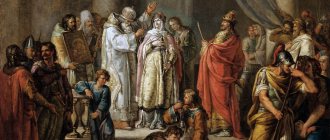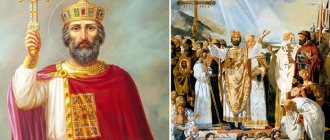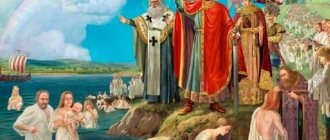- August 11, 2019
- Events
- Olga Strelkova
From the point of view of modern historians, the essence of the baptism of Rus' by Prince Vladimir is the introduction of Christianity into Kievan Rus as the state religion. According to tradition, according to chronicle chronology, this event dates back to 988. This date is also considered as the beginning of the official history of the Church in Russia. However, the question of what century the baptism of Rus' dates back to and to what year is currently debatable. Along with the above, other dates are also named. The history of the baptism of Rus' will be briefly discussed in the article.
Is the Baptism of Rus' a political move by Prince Vladimir?
Zlatnik of Prince Vladimir Svyatoslavich. 980–1015 State Hermitage
The Baptism of Russia is a conventional concept, behind which stands a whole series of decisions and events associated with different people and occurring at different times. Of course, the personal role of Prince Vladimir Svyatoslavich in the fact that the people of Rus' became Christian is great, but to reduce the whole matter to him alone from a historical point of view would be completely wrong. Vladimir is a kind of symbol of the adoption of Christianity by the Eastern Slavs. That is why he is revered as an Orthodox saint and is depicted in the images of historical memory (icons, paintings, monuments, and so on) of modern peoples who emerged from medieval Rus' - Ukrainians, Belarusians and Russians.
First of all, it is necessary to distinguish between the decision of the prince himself and some of his close relatives to accept baptism and the desire of the ruling elite of the Kyiv state to reject pagan cults and accept Christianity as the official and obligatory religion for the entire population. In addition, the introduction of an official and mandatory religion for everyone could not happen in one day and from scratch: an event of such a scale had many different prerequisites (and not only political, but economic and cultural).
When discussing the events of a thousand years ago, one must understand that very few sources from the reign of Vladimir have survived, and those that have survived are difficult to interpret unambiguously. In fact, only a few brief and fragmentary foreign messages have reached us, as well as some objects: for example, coins that began to be minted at the beginning of the 11th century at the court of the already baptized Vladimir, with his image as a Christian ruler (the prince is depicted with a cross and other attributes of the Christian faith , an image of Jesus was usually minted on the reverse side of the coin). Izvestia This is how chronicle messages are usually called in historiography. The Kyiv Chronicle and some other ancient Russian texts about the Baptism of Rus' were written down many decades after the death of the prince, and mostly these are just legends.
“The Tale of Bygone Years” “The Tale of Bygone Years” is an ancient Russian chronicle compiled in Kiev in the 1110s. Of several editions, two have reached us: as part of the Laurentian and Ipatiev Chronicles, which underlies the most common ideas about the events of that time, took a long time to develop. In the middle of the 11th - beginning of the 12th century, it was edited by several Kyiv scribes, so many contradictions can be found in the text. It is rather the fruit of historical and literary creativity, partially and distortedly telling about real events. It is not the “presumption of innocence”, but rather the “presumption of mistrust” that determines the attitude of modern historians towards him.
Bearing in mind all these circumstances, we must, firstly, admit that we cannot know the real motives of Prince Vladimir, who decided to be baptized, and secondly, that the decision to adopt Christianity as the state religion was a consequence of the interests of the elite of Kievan Rus and objective needs of this state.
Vladimir Monomakh - biography
Vladimir Vsevolodovich Monomakh - ancient Russian statesman, prince of Rostov (1066-1073), Smolensk (1073-1078), Chernigov (1078-1094), Pereyaslavl (1094-1113), and subsequently Kiev (1113 -1125). He is rightly called one of the most prominent figures in early Russian history.
Vladimir Monomakh is known not only as a major political figure of his time, but also as a talented diplomat, skillful military leader, thinker and writer.
Among other things, the prince made a great contribution to the development of legislation in Rus'; he became one of the few rulers who decided to reform the existing order. Even if for the most part it was a necessary measure.
Vladimir Monomakh's childhood and adolescence were spent in endless wars and battles with the steppe inhabitants. Confusion reigned around him, civil strife flared up every now and then, and intrigues arose in the struggle for the grand-ducal throne.
It was here that the prince showed his penchant for diplomacy. He did not seek to participate in squabbles between the princes and made the necessary compromises. At the same time, he slowly but surely took on more and more power, waiting for the right moment.
Thanks to his natural talent for combining gentleness and confidence in his actions, Monomakh managed to become a Grand Duke without unnecessary blood and sacrifices. He is also known for other acts that show his originality as a political figure and personality.
Content
If so, then when was Vladimir himself and his loved ones baptized, and when was the rest of Rus'?
Council of Vladimir Svyatoslavich with the boyars and squad about the place and time of the adoption of Christianity by Russia. Miniature from the Radziwill Chronicle. Late 15th century Library of the Academy of Sciences in St. Petersburg
According to the Tale of Bygone Years, the baptism of Prince Vladimir and his “squad,” that is, the Kiev elite, took place in Chersonesos in 988. In the same year, but a little later, when Vladimir and his army returned to Kyiv, by order of the prince, the people of Kiev were to be baptized. According to the Novgorod Chronicle, soon, although it is not known exactly when, baptism took place in Novgorod.
The Tale of Bygone Years speaks about baptism in other cities and regions subject to Kyiv:
“And [the prince] began to install churches and priests throughout the city, and bring people to baptism throughout the city and village. And, having sent, he began to take children from the deliberate child and give them for book teaching. And the mothers of their children wept for them, and for fear they had not yet confirmed their faith, but as if they were weeping for a dead man.” “And in other cities [the prince] began to build churches and appoint priests in them and bring people to baptism in all the cities and villages . He sent to collect children from the best people and send them to book education. The mothers of these children wept for them, for they were not yet established in the faith, and wept for them as if they were dead.” The Tale of Bygone Years. St. Petersburg, 1996. .
But there is another ancient text that describes a different chronology of the baptism of Vladimir and Rus'. This is the so-called “Memory and Praise to the Russian Prince Vladimir” by Jacob Mnich (that is, the monk), probably written in the middle of the 11th century. Jacob writes that the baptism of Vladimir and the capture of Chersonesos were not directly related. The prince was baptized in Kyiv back in 987, and captured Chersonesus and married Anna of Byzantium not in 988, but in 989.
In fact, the chronicle does not explain the reasons for the capture of Chersonesos. And in the text of Jacob and some other sources it is written that Vladimir decided to take the city in order to obtain the extradition of Princess Anna from Byzantium - the imperial family, apparently, desperately did not want to become related to the wild barbarian that the Greeks imagined the prince to be. Modern scholars have serious reasons to believe Jacob rather than the Tale of Bygone Years.
We have no other data on the chronology of Baptism, but it is clear that the Christianization of the entire population over a vast territory from the Black Sea steppes to the Novgorod forests could not take place in one day or even one year. The above quotation from The Tale of Bygone Years implies this by noting that many “have not yet become established in the faith”—obviously, “establishment” must have taken a long time.
Is it all the woman's fault?
According to Igor Danilevsky, there is another version of how all this happened. In 987, Prince Vladimir captured the Greek city of Korsun, which was located on the southwestern coast of Crimea (later it received the name Chersonesos). Vladimir promised to return the city to the Greeks if their emperors gave their sister, the Byzantine princess Anna, in marriage to Vladimir. This, among other things, significantly increased the status of Vladimir himself, who immediately found himself on a par with the Byzantine emperors. However, Anna refused to marry Vladimir as long as he was a pagan.
Further in the chronicle sources there is a mention of blindness, which strikes Vladimir at the moment when Anna arrives, accompanied by the clergy, in Korsun to meet with Vladimir. She invites him to be baptized immediately in the hope of healing. And the blindness really falls from his eyes when the prince accepts Christianity.
“Indeed, this is a very beautiful image when spiritual blindness leaves Vladimir: thanks to baptism, he “saw the light,” says Igor Danilevsky.
Were there any other options besides Orthodoxy?
Grand Duke Vladimir chooses faith. Painting by Ivan Eggink. 1822 State Museum of the History of Religion, St. Petersburg
The answer to this question can be found in the ancient Kiev chronicle, which was included in the Tale of Bygone Years. Its author, a chronicler who most likely lived in the second half of the 11th century, compiled the so-called story “about the choice of faiths.” In the “Tale of Bygone Years” under the years 986–987, it first says that proselytizers came to the court of the Kiev prince Vladimir Svyatoslavich. Proselytism is an activity aimed at converting people of other faiths to their religion. embassies of Mohammedans, Jews, Catholics and Orthodox Christians, and then that the prince himself, after consulting with the “boyars and elders” - the elite of the then society - sent his ambassadors to the Volga Bulgarians, the “Germans”, that is, the Catholics. and the Greeks “to experience the service of how to serve God” Tale of Bygone Years. St. Petersburg, 1996. .
This legendary story was based on folklore and literary motifs. But its essence reflected reality: in Kievan Rus they knew about different religions that were common in neighboring countries. The story “about the choice of faiths” says that Jews from Khazaria, Muslims from Volga Bulgaria, as well as Christians from Rome and Constantinople came into contact with Kiev. Sources independent of the chronicle, although they do not confirm exchanges of embassies at this time, do indicate contacts with these peoples in the religious sphere in the 10th century. For example, Princess Olga, Vladimir’s grandmother, was actually baptized in Byzantium. However, later, according to German sources, she, dissatisfied with political relations with Byzantium, turned to the German king Otto I with a request to send a bishop and priests to Rus'. In 961, a German bishop even arrived in Kyiv, but his mission (he was supposed to convert Rus' to Catholicism) ultimately failed.
Prince Yaropolk Svyatoslavich, Vladimir’s elder brother and his predecessor on the Kiev “table,” that is, the throne, also had contacts with the German imperial court. Some historians, not unreasonably, believe that Yaropolk even managed to receive Catholic baptism before the war with Vladimir, in which he died.
On the other hand, no later than the middle of the 10th century, a Jewish community was formed in Kyiv. This is evidenced by the oldest document created in Kievan Rus - the so-called Kievan letter, a message in Hebrew on behalf of this community, preserved in the Cairo Geniza - the archive at the synagogue. It was about financial assistance to one of the community members. Unfortunately, this message does not have an exact dating, but scientists place it around the middle of the 10th century. Among the names of community members there are Slavic ones, and this directly confirms Jewish proselytism in the capital of Rus'.
There is no direct evidence of Islamic proselytism on the territory of Rus'. But in Rus' they knew exactly what Islam was: since the 9th century, it was united by close, primarily trade and economic, but also military contacts with Volga Bulgaria and the Arab Caliphate. We have a variety of evidence about these contacts (including from Arabic sources of the late 9th - early 10th centuries), and often in the form of detailed stories.
Theoretically, the elite of the Kyiv state could turn to different countries with a request for help in establishing a monotheistic religion. A Western alternative was also possible, that is, the adoption of Christianity from the Roman Curia through Germany.
But Orthodoxy, which came from Constantinople, had the greatest chances: back in the 9th century, Christianity began to spread from there to the north, mainly to the Slavic regions. Naturally, for Dnieper Rus', the path to breaking with paganism led to Byzantium, with which the ruling elite of Rus' had the closest trade and economic relations. Arab writers report that at the end of the 9th century, some merchants from Rus' who came to the Arab Caliphate said that they had been baptized.
Of great importance is the evidence of the treaty between Russia and the Greeks in 944, which was included in the “Tale of Bygone Years” in a copy with a translation into Church Slavonic. Some of those who concluded it from the Russian side were Christians and swore according to Christian rites, that is, they kissed the cross. And among the archaeological finds of the late 9th - early 10th centuries there are objects of Christian worship: crosses, candles and the like.
The Baptism of Rus' and the legacy of paganism
Why did Vladimir choose Christianity? Lecture from the course “History of Russian Culture”
The first Christians
After Oleg’s political and trade agreements with Constantinople, Russian-Byzantine ties began to strengthen. Byzantine merchants actively flocked to the Slavic lands, and missionaries became frequent guests in the Black Sea region and on the banks of the Dnieper. Although the baptism of Russians was not of a mass nature, it is quite likely that by the middle of the 10th century a Christian community already existed in Kiev. The penetration of Christianity into Kievan Rus is evidenced by the mention of the cathedral church of Elijah the Baptist in Kiev in the Russian-Byzantine treaty of 944. Among those who were baptized was Princess Olga of Kiev. This event became significant, since Olga became the first ruler in the history of the Ancient Russian state to break with paganism. “For the next generation, the example of an energetic, intelligent princess broke the ice of coldness and prejudice against Christianity, which now no longer seemed so alien, unusual and inappropriate important for Russia,” wrote historian Vladimir Parhomenko.
The date and circumstances of Olga’s baptism are not completely clear. The author of “The Tale of Bygone Years” connects this event with the princess’s trip to Constantinople. The chronicler's narrative is in some places full of fabulous details, but the fact of baptism itself does not raise doubts among historians, since it is confirmed by many Byzantine sources. Based on these documents, Olga's baptism is dated to 957. Olga's (baptized Elena) adoption of Christianity was rather private and did not in any way affect those close to her or her son Svyatoslav. “How do I want to accept one law? And my squad is hesitant to start,” Svyatoslav answered his mother to her calls to be baptized. In the 971 agreement between Prince Svyatoslav and the Byzantine Emperor Tzimiskes, we still see Russia, which swears by Perun and Volos. The new faith first of all affected the trading people, who often visited Constantinople, since the adoption of Christianity provided them with much more favorable conditions in Byzantium. In addition to the merchants, Russian warriors who were in the service of the Byzantine emperor also willingly embraced Christianity. It is these “Russian Christians” who, upon returning home, replenished the Christian community that Konstantin Bagryanorodny mentions.
What would have happened if Rus' had not been baptized? Would we remain pagans?
The reign of Vladimir Svyatoslavich in Kyiv; the erection, at his command, of wooden figures of the god Perun and other pagan deities on the hill. Miniature from the Radziwill Chronicle. Late 15th century Library of the Academy of Sciences in St. Petersburg
Probably, for some time paganism could exist in Russia as the main cult. In any case, it is known that in neighboring Poland, after the adoption of Christianity at the end of the 10th - beginning of the 11th century, a period of pagan reaction began (it was expressed in a series of uprisings against the ruling Piast dynasty in the 1030s), and in more distant Scandinavia Christianity remained for a long time ( until the end of the 12th century) gained ground. But paganism was doomed to disappear. There is an example of some West Slavic tribes (Polabian Slavs - Obodrits, Lutichs and others), who, in the face of German aggression in the 10th-12th centuries, acting under the slogans of baptism, “mothballed” their pagan beliefs. For some time, this conservation helped them defend their original culture and political independence, but by the end of the 12th century they lost their independence and became part of the German states. But those Slavs who adopted Christianity were just able to defend their independence.
Choice of faith
Meanwhile, Ancient Russia was getting closer and closer to the moment when a single faith had to subjugate disparate tribes to princely power. Historian Boris Grekov noted the attempts of Vladimir Svyatoslavich, with the help of a pantheon of various pagan gods, to create a religion “that could more firmly unite his entire state.” The dying paganism turned out to be a bad unifying principle and could not prevent the collapse of the huge tribal union led by Kiev. Apparently, it was then that Vladimir turned his attention to monotheistic religions.
Vladimir’s choice of religion is often associated with a legendary story called “test of faith.” The Kiev prince, having listened to the sermons of representatives of Roman Catholicism, Bulgar Mohammedanism, Khazar Judaism and Greek Orthodoxy, sent his representatives to these countries for intimate acquaintance with liturgical rites.
The chronicler reports that the envoys who returned from Constantinople with the words “They did not know where we were - in heaven or on earth” made the strongest impression on Vladimir. This determined the choice of faith according to the Greek rite. Many historians, although they are skeptical about the story about the “test of faith”, endowing it with a bookish, instructive character, still recognize that real events could lie at the basis.
A well-known expert on Ancient Russia, Vladimir Mavodin, believes that in this story one can see “snippets of memories of real historical events that clearly reflect Russia at the crossroads.” In particular, the authenticity of such events can be evidenced by the message of the 13th century Arabic writer Muhammad al-Aufi “about the embassy of Bulamir (Vladimir) to Khorezm for the purpose of “testing” the mu Islam and the despatching of a Muslim imam to Russia to convert Russians to the Mohammedan faith.”
One way or another, the decision to baptize Russia was not based solely on the opinion of the embassy. The adoption of a single religion for Vladimir was determined primarily by political motives, the difficult situation not only within the state, but also on its outskirts.
At that time, the southern borders of Russia were constantly attacked by nomads, who burned fields, ravaged villages and besieged for years. Under these conditions, Vladimir counted on friendly and allied relations with Byzantium, which could only exist after the Ancient Russian state adopted Christianity. The historian Mikhail Pokrovsky attributed an important role in the baptism of Russia to the upper layer of ancient Russian society - the princes and boyars, who “disdained the old, Slavic religious rites and glory Yang sorcerers, “magi”, and began to write down for themselves, along with Greek silk materials and gold jewelry, and Greek rituals, and the Greek “magi” - priests.” A specialist in ancient Russian history, Sergei Bakhrushin, places slightly different emphasis, noting that in the 10th century a layer of feudal nobility was formed in Russia, which “was in a hurry to assert your claims to a dominant position.” Today it is not known for certain where Vladimir was baptized. The traditional version, according to which the Kiev prince was baptized in Chersonesus, is rejected, in particular, by academician Alexey Shakhmatov, who believes that the news of the Korsun campaign Prince Vladimir - “the latest insertion that destroyed the original chronicle text.” There is no exact data about the baptism of Kiev residents: some researchers believe that mass baptism took place in Dnieper, others call Pochaina. According to modern historians, the year 988 can be considered only a conditional date for the baptism of the entire Ancient Russian state. Russian religious scholar Nikolai Gordienko connects this event exclusively with the “conversion of Kievans to Christianity,” which became only one of the initial moments of a process that lasted for many years, beyond often a painful process of adoption of the new faith by residents of the entire Ancient Russian state.
Was Rus' forcibly baptized?
Baptism of Rus'. Sketch by Viktor Vasnetsov for the painting of St. Vladimir's Cathedral in Kyiv. 1890 State Tretyakov Gallery
The oldest sources do not report any violence: neither from other states, nor from the Kiev authorities. The literature still refers to reports of some resistance to baptism with armed confrontation (for example, in Novgorod), but this is unreliable information based on later speculation and legends.
Results of the board
The years of Monomakh's reign (1113 - 1125) were marked by several major events:
- Vladimir Vsevolodovich led more than 80 campaigns against external and internal enemies. Strengthened the international authority of Rus'. In the first years of his reign, he tried to participate in the processes of maintaining the fragile balance between the princes.
- Monomakh acted as an organizing factor that allowed him to unite individual rulers against an external enemy. In many ways, it was through his efforts that it was possible to significantly delay the onset of feudal fragmentation and the appanage period of Rus'.
- It was important to change the order of succession to the throne (Lubech Congress), according to which each prince had to rule in his own lands. It was a compromise that allowed the status quo to be maintained at least for a while.
- Inflicted several sensitive defeats on the Polovtsians, pacifying the steppe inhabitants. Thanks to this, he gave the necessary time for development.
- Monomakh made a great contribution to the culture of Rus'. Chronicle writing activities were carried out under his leadership. Also, on his own, he prepared one of the first secular sermons - “The Teachings of Vladimir Monomakh.” An important monument of Russian history and cultural studies.
- Vladimir Vsevolodovich played a big role in the development of Russian law. In addition, he made a significant contribution to the formation of the social structure of society at that time.
Evaluations of his activities are predominantly positive. Although there is no consensus about the reign of Vladimir Monomakh.
Was there resistance and protests?
Prince Gleb Svyatoslavovich kills the sorcerer at the Novgorod Veche (Princely Court). Painting by Andrey Ryabushkin. 1898 Nizhny Tagil Museum of Fine Arts
We know nothing about resistance and protests in the era of Vladimir. Another thing is that the Christianization of the entire population of Rus' was a long process: the chronicle reports some unrest in individual cities and regions of Rus' later, in the 11th century. To varying degrees, the protesters used slogans of pagan reaction. For example, in Suzdal in 1024 there were unrest due to famine, and pagan Magi (priests) took an active part in them. Under the year 1071 (in reality, the events most likely took place in 1074), the Tale of Bygone Years describes the adventures of the Kyiv boyar Yan Vyshatich in the Upper Volga region. Famine reigned in Rus' at that time, and unrest against the authorities began. Jan had to suppress them and even conduct a theological dispute with the Magi, who were depicted as the leaders of the protest. In Novgorod in 1071, a revolt against the prince and bishop was also led by a certain sorcerer; unrest occurred during the evening, but the decisive actions of the prince and his squad stopped them.
Rurik Dynasty
The legendary Rurik dynasty marked the beginning of the reign in Rus'. Rurik is the founder of Kievan Rus. Over time, the family continued the royal line, but eventually the family tree split into many branches . You can clearly trace the actual branching of the Rurik dynasty in the diagram with the dates of reign.
Maintaining unity came at a heavy price for the Rurik family. The fragmentation occurred during the reign of Vladimir Svyatoslavovich. From this time on, the formation of appanage dynasties began.
After that, did they immediately start building churches and painting icons?
The consecration of the Mother of God (Tithe) Church in Kyiv, built by order of Vladimir Svyatoslavich by Greek craftsmen and decorated with icons and utensils from Korsun, and the appointment of Anastas and other Korsun priests as ministers in it. Miniature from the Radziwill Chronicle. End of the 15th century Library of the Academy of Sciences in St. Petersburg
The chronicle reports that after mass baptism in Kiev, by order and at the expense of the prince, they began to “set up churches and priests throughout the city” The Tale of Bygone Years. St. Petersburg, 1996.. It specifically talks about the construction of the Tithe Church of the Virgin Mary in the city. It began to be called tithe because a tenth of the prince’s income was allocated to support it. The church was a very representative building; it was decorated with mosaics and frescoes. It was severely damaged during the capture of the city by the Mongols at the end of 1240, and then gradually collapsed until the 20th century. Archaeologists discovered its foundation (which can still be seen today) and confirmed that the church was built at the end of the 10th century. It is known that after the death of Vladimir in 1015, there were already hundreds of churches in the city: in addition to the Tithe Church, the then wooden St. Sophia Cathedral and other large churches, numerous small private churches and chapels were also built. Obviously, they must have had some kind of icons, but the oldest surviving icons of pre-Mongol Rus' date back to no earlier than the middle of the 11th century.
Family and Children
According to Russian historiography, Vladimir Monomakh was married three times.
The first wife is the fugitive English princess Gita of Wessex. From this union five children were born: Mstislav, Vyacheslav, Izyaslav, Yaropolk and Svyatoslav. They bore Slavic names.
Gita of Wessex
In the late 90s, he married a certain Efimiya. So presumably it was of Greek origin. This marriage produced six more children.
Efimiya
Three daughters (Agathia, Maria and Euphemia), as well as the sons of Vladimir Monomakh Roman, Andrei and Yuri, who went down in history under the nickname Dolgoruky.
The last alleged wife of Vladimir Monomakh was the daughter of the Polovtsian khan.
And everyone started wearing crosses?
The pendant cross is one-sided. Veliky Novgorod, late 11th century Institute of Archeology RAS
Yes, after baptism, many actually began to wear crosses. In the graves of the 11th century, burials in which were performed according to Christian rites, the dead, as a rule, lie with crosses. In chronicles and other texts of the late 11th - 12th centuries, the custom of wearing a pectoral cross is already mentioned as a matter of course and universal.
Where did the priests and other clergy come from?
Baptism of Princess Olga in Constantinople. Sketch by Ivan Akimov. 1792 State Russian Museum
The first clerics Cleric is the general name for clergy or clergy. began to appear in Kyiv and, probably, in other cities of Rus' long before 988. As we already wrote above, Princess Olga was baptized in Constantinople, and the Byzantine sources reporting this mention that she had a priest with her, who, apparently, stayed with her in Kyiv. According to the chronicle, Vladimir brought some clergy with him from Chersonesos. Some clergy probably arrived with the metropolitan, who came to Kyiv within a few years after the Epiphany. Later, the clergy were recruited from the local population. The chronicle speaks about this, albeit in the form of legends, in the news about the “book teaching” (meaning that “teaching” is necessary for worship) of the children of the “deliberate child”, that is, the children of the “best people”. The Tale of Bygone Years. St. Petersburg, 1996. .
